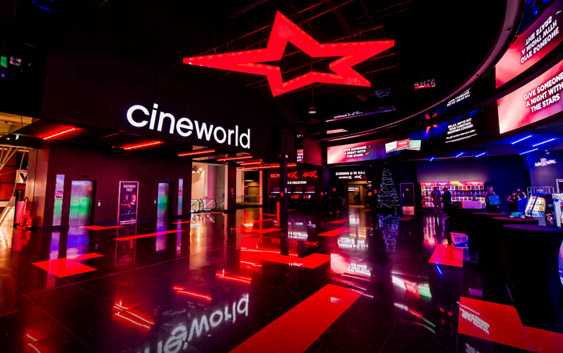Cineworld Is Dead. Long Live Content.

Imagine if Manchester United suddenly went bankrupt; ceased to exist. Over one hundred years of history would be washed away, video archive sold to the highest bidder and everything else put to waste. Old Trafford would be left to rot, a monument of those memories forged through desperation and elation. The tens of thousands of fans who’d frequent that stadium every other week of the year would suddenly have nowhere to go. The businesses around the stadium, throughout Manchester, would no longer have those currents of people passing their doors, walking in for a cup of tea, a beer, a pasty or a burger. Public transport would take a hit, local hotels would suffer, car parks would be empty. Together, we’d pay the price for Manchester United’s absence. Public transport owners would tackle falling demand with a rise in ticket prices, the shops would close due to lack of custom, broadcasters would be offering less for their money, the wider game of football would suffer. Most importantly, however, the Theatre of Dreams would no longer stand as a symbol of what any young person can achieve, it would no longer provide a safe space for those in need of escape, it would no longer be a meeting place for those who seek companionship in an increasingly fractured world, and there’d be an uproar at the cultural loss that was to be felt across Manchester, the United Kingdom, and the world.
Losing Manchester United seems too impossible to even consider. So why is cinema about to lose its version of Manchester United to bankruptcy?
The Story
On Friday 19th August 2022, The Wall Street Journal revealed that Cineworld Group plc would be filing for bankruptcy; the second-biggest film exhibitor in the world, with over 9,500 screens at 790 sites and around 28,000 employees, would cease to exist. It’s a business that far outweighs Manchester United in real terms – spatial, employment, worth – and yet there is so little to be read or spoken of regarding the cultural impact of this loss, or the massive void that the Cineworld Group will leave.
This isn’t new… cinema as an industry has long been overlooked. It barely gets coverage in the news, newspapers, or even on sites like this. Is cinema art? Is it business? Most places like to approach it as just one or the other, and in almost every case (including here on The Film Magazine) it is approached as an art form. Is said art good? Why is it good? Little is ever made of the tens of billions of pounds the film industry contributes to the UK economy per year, or the billions more around the world, nor is much ever discussed about how this is important, why it’s important, and why cinemas in of themselves should be considered institutions on the levels of theatres (whether they be theatres of dreams or playwrights). It’s like cinema is the secret love child of both industry and art, and this strange underselling of its impact leads to situations in which the Manchester United of film exhibition can shut down and leave hundreds of sites empty (many with immense historical value), leave thousands of people without employment, and nothing happens. No uproar, no crying out, no mass sense of loss or guttural feeling of grief, just a brief news story about yet another business failing to keep its head above water. All of this, in its absence of heart and of critical thinking, in the most lucrative art form on the planet. It’s nonsensical.
Cineworld’s Issues
Cineworld Group plc, like Manchester United, is not without its criticisms. Abhorrent choices at board level have seen it pay out nearly £1billion in court-ordered fines and compensation in recent years, meanwhile its workers were quickly dismissed in the wake of the pandemic before being promptly rehired upon the UK government’s furlough scheme being announced. In strictly UK terms, the employees of subsidiary Picturehouse went on strike about their minimum wage pay and as such the brand had all ties severed to the London Film Festival by the festival’s founding body, the British Film Institute.

Critics have argued that Cineworld’s tickets are too expensive, the experience of going to the cinema not what it once was, and there is no doubt that the ongoing cost of living crisis and all the ramifications of the pandemic and Brexit have halted the ability of the average Joe to spend their hard-earned money on a day out to the cinema.
How Are They £4billion In Debt?
Cineworld is one of many multi-billion-dollar corporations to have loaded itself with debt in order to undergo aggressive expansion. In 2017, the London-based firm paid £3billion for the United States’ Regal Cinemas chain, a massive investment that they haven’t been able to recover from. This, plus the court-ordered payments amassing almost £1billion, and pandemic-era closures, have left them unable to reduce said debt.
At a corporate level, statements have blamed the film studios, claiming that audiences are unwilling to revisit cinemas because of a lack of marquee blockbusters, as well as the industry’s massive release delays that saw most of the big budget movies delayed from 2020 until the autumn of 2021, nearly eighteen months after cinemas were first closed. There is some truth to this.
The box office is down by around 33% in 2022 when compared to pre-COVID 2019, while in 2021 the total was down 48% on the three year average from 2017 to 2019.
Studios Have to Take Some Responsibility
The big Hollywood film studios have been strangling exhibitors for years, trending towards a streaming model as opposed to a theatrical one at a rate of knots only accelerated by the COVID-19 lockdowns that caused cinema closures for almost twelve months in total.
Disney are the biggest offenders, particularly in light of purchasing their biggest studio rival 20th Century Fox in 2019 (and thus increasing their average annual share of the box office to over 60%). As a requirement, Disney films will only be shown in your local cinema if said cinema gives the company 65% of all ticket revenue in some cases – this is 15-20% more than other studios. Furthermore, Disney will require that any cinema must play their film in that cinema’s biggest screen for a minimum of three weeks, dictating the exhibition experience and thus restricting our access (as consumers) to a fair market. From the perspective of a company like Cineworld, this means that even when a Disney film isn’t performing well, it must remain on the biggest screen. Recent examples of this have been Black Widow and Shang-Chi and the Legend of the Ten Rings, each of which were relatively low performers compared to the average Marvel movie and some of the films released in the same time period. Because Disney held the contractual requirement to show said films on the cinema’s biggest screens, other hits couldn’t house as many butts in seats, and as a trickle down effect of this dictatorial approach smaller films didn’t have smaller screens to move into and the chains were therefore restricted in their attempts to cater to more niche audiences.

During the pandemic era, studios were also quick to reduce the all-important theatrical window. Pre-pandemic, it would take a minimum of seventy-five days for any film to be released digitally. Post-pandemic that number has reduced to as little as seventeen days in some cases, thirty days in others, and forty-five in most. Warner Bros and Universal were the leaders in this new tactic, their decisions to release the likes of Trolls World Tour and Scoob! day-and-date (in cinemas and on streaming on the same day) causing massive anxiety to cinema chains in 2020, with some even refusing to screen the films at all.
The industry used to dictate that a wait of 9-12 months was necessary before consumers could access a cinema release on television at home as part of a subscription (in most cases satellite television). It used to be six months before said cinema releases were available on home video (DVD/BR). That time period is now sometimes as little as one month. If you’re a family paying for Disney Plus, why would you pay for four cinema tickets, concessions, a parking ticket and petrol, to see a film you can watch at home in a matter of weeks for what is effectively a non-cost (seeing as you’re paying the subscription fee anyway)? In the economy we’re living in, you wouldn’t. And that’s how the big film studios have negatively affected the culture of filmgoing.
What Is Cinema in 2022?
As studios have invested massive amounts into their streaming services, they have each sought to protect their investments by any means necessary. The theatrical window has been reduced (though not eradicated due to it being a viable financial opportunity for major studio releases), and perhaps most insipidly these studios have begun to blur the lines between television, TV movies, and cinema, as a means of spending less to get you to watch more.
In 2022, the big question investors have in corporate giants with streaming services is “who has the most watch hours?” It’s a way to decipher which services are likely to increase in subscribers (thus increase in share value), and which services would earn the most money from advertisers should advertisements be introduced – Netflix and Disney have already announced plans to introduce advertising in the near future to “battle costs”. To an investor, it doesn’t matter how good the art is, only that it keeps your attention. That’s why blockbuster movies seem longer than ever: they’re no longer designed to be shown as many times as possible, only to be watched for as long as possible.

Spider-Man: No Way Home was two hours and twenty-eight minutes. Eternals was two hours and thirty-seven minutes. The Batman was two hours and fifty-six minutes. These aren’t films to be quickly watched, ingested and then rewatched in the cinema – they’re products to watch in the cinema and then rewatch at home. And these are massive blockbusters… the exact films that are supposed to best exemplify the reason to keep going to the cinema.
If Cineworld is open from 12pm-12am and shows The Batman in just one screen, they can only show the film four times per day (not accounting for cleaning, maintenance, management, etc.). If the film is half as long, Cineworld can show it eight times per day. Studios used to make significant moves to ensure their films were lean so as to make the most money they could from theatrical releases – the more showings, the more opportunities to sell tickets – but with a change in focus has come a massive hurdle for the exhibitors to navigate; one that Cineworld has ultimately suffered from. And that’s not even getting into the general issues of suggesting a person sits in the same place for three hours when they might have a babysitter at home, accessibility issues, small children with them, etc.
Cinema Is Dead
If you ask the average member of the public why they haven’t been to the cinema in a while, their answer will likely include a mix of things that companies like Cineworld could have done better and a number of issues related to the film releases themselves.
The exhibitors, Cineworld included, should have done more to uphold the sanctity of the theatrical experience. People hate unrest, irritations, limitations. Seeing a film that is three hours without an intermission is tough for people. Massive releases like The Lord of the Rings and Pirates of the Caribbean managed it in the 2000s, so why is this no longer an option? Furthermore, people now associate their cinema experience as a less comfortable version of what they get at home. More regular inspections of screens to restrict access to phones should have been the first post-pandemic order, and an industry-wide standardisation for projection and seating should have been enacted – all it takes is one bad experience to put a customer off forever. Make visiting the cinema an event that can’t be matched, just like a football match, stage show, or music concert.

To many, the films aren’t good enough. Why would your average sixty-year-old want to see The Suicide Squad or Lightyear? They wouldn’t, and after a long enough period of seeing increasingly infantilised family movies dominate cinema screens, looking at the listings no longer becomes a part of a routine and thus their patronage is lost. Meanwhile, those casual cinema-goers inclined to watch comic book movies and animated films often just wait for them to go onto streaming in a matter of weeks. And what is even good nowadays? It is truly more difficult than ever to tell, which is due in part to a corporate destruction of the critical realm and an advertiser-driven agenda against the critical voice.
Long Live Streaming
In the studios’ pursuit of watch-time above ticket sales, quantity over quality, and low investment for high reward, Hollywood has cannibalised its own industry to such a point that the downfall of firms as large and as powerful as Cineworld Group plc has long seemed inevitable. And, yet, it doesn’t hurt any less.
Should Cineworld’s bankruptcy force closure, 28,000 people will be without work in the midst of a cost of living crisis that is rapidly transferring wealth from the poor to the rich, and each will be left with almost nothing to tackle a cold and harsh winter with. Furthermore, hundreds of buildings will be left empty, their fit-for-use architecture left as a constant reminder of what once was, their maintenance costs picked up by local councils and wider governmental funds.

The Cineworld logo may be repurposed and resurrected just as the Blockbuster one has been in recent months, and other cinema chains will undoubtedly limp on in the face of total oblivion, but these buildings and all the patronage they encourage to surrounding businesses and infrastructure will become baron, that money no longer cycled through the same spots, no longer propping up the same coffee shops and newsagents. That Great British Pound Sterling once spent on a taxable ticket, then circulated on further taxable goods at adjacent shops, restaurants, parking spaces and public transport, will instead be consumed by the American corporations paying little-if-any tax on ever-inflating subscription fees – this truly is a transference of wealth issue.
Perhaps most damagingly of all, however, is the loss of this once great institution we have known as the theatrical experience. Close to 800 cinemas on the brink, more likely to follow. Every first-ever cinema experience, every nervous date at the movies, every life-changing film, every showing packed with smiling faces, gone.
Where now will we dream? Where will we be able to escape the rigours of life? Where will we forge our greatest relationships, share in existential dread and life-affirming moments? Where now will we learn of our history, of our culture, of ourselves?
To bring the opening comparison full circle: it is clear to everyone that football clubs big and small are vital parts of any UK city’s community, identity, economy; so is it not time for us to consider cinemas as equal in this respect given how many there are, how often they’re frequented, the numbers they attract, the locations they occupy? If Manchester United suddenly closed, its gates locked and its stadium left to a council without the funds to support redevelopment or repurpose, we would describe that as a failure. If Cineworld loses 790 cinemas, those fit-for-purpose buildings left abandoned or shoddily recycled, we ought to see that as a failure too. A failure for our economy, for our community, for the art form, for ourselves. Ask yourself: what kind of society doesn’t care about access to art? The answer is simple, but perhaps the most damaging statement of them all.
Cineworld is dead. Long live streaming.
— Donate via Paypal to ensure The Film Magazine remains free and available for everyone. —

